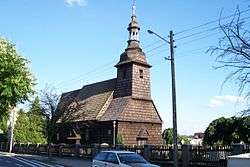Dobrodzień
| Dobrodzień Guttentag | ||
|---|---|---|
|
Saint Valentine Church | ||
| ||
 Dobrodzień Guttentag | ||
| Coordinates: 50°43′40″N 18°26′40″E / 50.72778°N 18.44444°E | ||
| Country |
| |
| Voivodeship | Opole | |
| County | Olesno | |
| Gmina | Dobrodzień | |
| Area | ||
| • Total | 19.46 km2 (7.51 sq mi) | |
| Population (2006) | ||
| • Total | 4,168 | |
| • Density | 210/km2 (550/sq mi) | |
| Postal code | 46-380 | |
| Area code(s) | +48 34 | |
| Car plates | OOL | |
| Website | http://www.dobrodzien.pl | |
Dobrodzień [dɔˈbrɔd͡ʑeɲ] (German: Guttentag) is a small town in Olesno County, in Opole Voivodeship, Poland. Located in the Upper Silesia historical region, it is the administrative seat of Gmina Dobrodzień
Both names in Polish and German mean "Good day". Guttentag is an archaic variant of standard German Guten Tag, while Dobrodzień is an archaic variant of standard Polish Dzień Dobry.
History
The area is documented as part of the Upper Silesian Duchy of Opole since about 1163 under the rule of Duke Bolesław I the Tall. The name Dobrosin was first recorded in a 1279 deed; the name varied throughout the centuries (Dobradin, Dobrodzen, Dobrodzin, Dobrydzień etc.). From 1327 onwards, the town belonged to the Kingdom of Bohemia, which itself fell to the Austrian Habsburg Monarchy in 1526. Dobradin received town rights according to Magdeburg law in 1384. The first mention of the German name Guttentag occurred in 1636.
With the Duchy of Opole as a fief of the Bohemian Crown, Dobrodzień remained part of the Habsburg Empire until 1742, when upon the First Silesian War it was annexed by the Kingdom of Prussia according to the Treaty of Breslau. Incorporated into the Prussian Province of Silesia, it became part of the German Empire in 1871.
German-Polish border changes impacted Guttentag/Dobrodzień twice in the 20th century: First, after World War I and the Silesian Uprisings, a portion of the Upper Silesian region (East Upper Silesia) became part of Silesian Voivodeship in the re-established Second Polish Republic. In the 1921 Upper Silesia plebiscite, 79.5% of the citizens came out in favour of a continuance in Germany. While most parts of the Lubliniec District fell to Poland, Guttentag remained in the Prussian Province of Upper Silesia and ended up very close to the new German–Polish border. Second, after 1945, as part of Potsdam Agreement by the Allied victors after World War II, most German territories east of the Oder–Neisse line (including Guttentag) became part of the Republic of Poland. Up till then the town had a mostly Protestant population, but after the expulsion of most of the German inhabitants, it was resettled with mainly Catholic Poles. Dobrodzień's German-Protestant legacy can still be seen in the Luther rose on its coat of arms.
Dobrodzień and most of the surrounding towns are at present officially bilingual in both Polish and German; a sizable German minority (25.3% according to the 2002 census) has continued to settle in the area even after the war.
Notable residents
- Abraham Cohn (1832-1897), German-American Civil War soldier
- Georg Gürich (1859–1938), German geologist
- Anton Korol (1916–1981), Luftwaffe pilot
Gallery
 Mary Magdalene Church
Mary Magdalene Church Saint Mary Church
Saint Mary Church Town market
Town market Town market
Town market The park
The park 17th-century bridge
17th-century bridge
External links
- Official site (in Polish)
- Jewish Community in Dobrodzień on Virtual Shtetl
| Wikimedia Commons has media related to Dobrodzień. |
Coordinates: 50°44′N 18°27′E / 50.733°N 18.450°E

